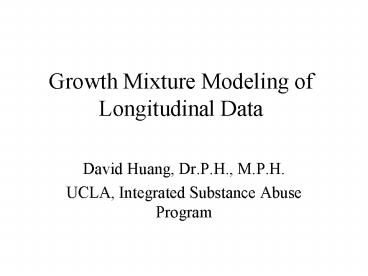Growth Mixture Modeling of Longitudinal Data - PowerPoint PPT Presentation
1 / 27
Title:
Growth Mixture Modeling of Longitudinal Data
Description:
Subjects have repeated measures on some characteristics over time, which could be ... 436 male heroin addicts who were admitted to the California Civil Addict Program ... – PowerPoint PPT presentation
Number of Views:438
Avg rating:3.0/5.0
Title: Growth Mixture Modeling of Longitudinal Data
1
Growth Mixture Modeling of Longitudinal Data
- David Huang, Dr.P.H., M.P.H.
- UCLA, Integrated Substance Abuse Program
2
Longitudinal Data
- Subjects have repeated measures on some
characteristics over time, which could be - Medical history (ex blood pressure)
- Childrens learning curve (ex. math score)
- Babys growth curve (ex. weight)
- Drug use history (ex. heroin use)
3
(No Transcript)
4
Growth Curve Modeling
- Level 1 represents intra-individual difference in
repeated measures over time. (individual growth
curve). - Level 2 represents variation in individual growth
curves.
5
Growth Curve Model with One Class (N 436)
Days use per month
Years Since The First Use
6
Limitation of Growth Curve Model
- Assume that growth curves are a sample from a
single finite population. The growth model only
represents a single average growth rate.
7
Growth Mixture Modeling
- Including latent classes into growth curve
modeling. - Modeling individual variation in growth rates.
- Classifying trajectories by latent class
analysis.
8
Growth Mixture Model in Mplus
Source Terry Duncan (2002). Growth Mixture
Modeling of Adolescent Alcohol Use Data.
www.ori.org/methodology
9
Source Terry Duncan (2002). Growth Mixture
Modeling of Adolescent Alcohol Use Data.
www.ori.org/methodology
10
Source Terry Duncan (2002). Growth Mixture
Modeling of Adolescent Alcohol Use Data.
www.ori.org/methodology
11
Source Terry Duncan (2002). Growth Mixture
Modeling of Adolescent Alcohol Use Data.
www.ori.org/methodology
12
Source Terry Duncan (2002). Growth Mixture
Modeling of Adolescent Alcohol Use Data.
www.ori.org/methodology
13
Source Terry Duncan (2002). Growth Mixture
Modeling of Adolescent Alcohol Use Data.
www.ori.org/methodology
14
- This study is based on 436 male heroin addicts
who were admitted to the California Civil Addict
Program at 1964-1965 and were followed in the
three follow-up studies conducted every ten years
over 33 years.
15
Growth Curve Model with Two Classes (N 436)
Days use per month
Years Since The First Use
16
Growth Curve Model with Three Classes (N 436)
Days of use per month
Years Since The First Use
17
Growth Curve Model with Four Classes (N 436)
Days of use per month
Years Since The First Use
18
Growth Curve Model with Five Classes (N 436)
Days of use per month
Years Since The First Use
19
Goodness of fit
- Loglikelihood
- Akaike Information Criterion (AIC)
- Bayesian Information Criterion (BIC)
- Sample-size Adjusted BIC
- Entropy
20
Adjusted BIC Index by Latent Classes
Adjusted BIC
Latent Classes
21
Difficulties in Model fitting
- EM algorithm reaches a local maxima, rather than
a global maxima. - Repeat EM algorithm with different sets of
initial values. - Use BIC to compare the goodness-of-fit of models
22
Example of Wrong Starting Values
23
(No Transcript)
24
Difficulties in Model fitting
- EM algorithm would NOT converge.
- Start with a simple model. Set variance of
intercept and slope at zero. Assume residuals
are constant across the classes.
25
Difficulties in Model fitting
- Individual classification is model dependent and
initial value dependent. Individual
classification could vary in different models.
26
(No Transcript)
27
References
- Terry Duncan (2002). Growth Mixture Modeling of
Adolescent Alcohol Use Data. www.ori.org/methodolo
gy - Muthén, B. (2004). Latent variable analysis
Growth mixture modeling and related techniques
for longitudinal data. In D. Kaplan (ed.),
Handbook of quantitative methodology for the
social sciences (pp. 345-368). Newbury Park, CA
Sage Publications.































